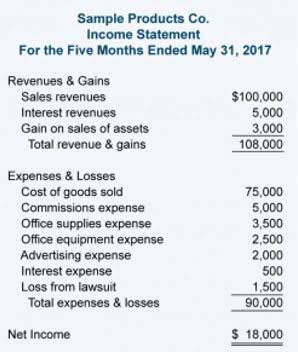
The statement of stockholder’s equity displays all equity accounts that affect the ending equity balance including common stock, net income, paid in capital, and dividends. This in depth view of equity is best demonstrated in the expanded accounting equation. This statement lists the changes to the stockholders’ equity section of the balance sheet during the current accounting period. The net income from operations and other business activities maintained by a firm as additional equity capital is referred to as retained earnings (RE). Many of the other adjustments in the operating activities section of the SCF reflect the changes in the balances of the current assets and current liabilities.
- It is the gap between the number of shares issued and the number of shares outstanding.
- The cost of the hours worked through December 31 must be included in the company’s December expenses and in the liabilities as of December 31.
- They also have to communicate clearly to shareholders how these initiatives will lead to long-term value.
- There are several implications when using shareholders’ equity for CSR and sustainability initiatives.
- When you review the statement of stockholders’ equity you will see that it reports the amounts for each of the most recent three years.
- This is an account on a company’s balance sheet that consists of the cumulative amount of retained earnings, contributed capital, and occasionally other comprehensive income.
Do you already work with a financial advisor?

If a company doesn’t wish to hang on to the shares for future financing, it can choose to retire the shares. For this reason, many investors view companies with negative shareholder equity as risky or unsafe investments. Shareholder equity alone is not a definitive indicator of a company’s financial health. If used in conjunction with other tools and metrics, the investor can https://www.bookstime.com/ accurately analyze the health of an organization.
Cash Flow Statement: Breaking Down Its Importance and Analysis in Finance

The Shareholders’ Equity Statement holds paramount significance, serving as a crucial financial statement for various stakeholders including the company, shareholders, and potential investors. Note that the company had several equity transactions during the year, and the retained earnings column corresponds to a statement of retained earnings. Companies may expand this presentation to include comparative data for multiple years. This format is usually supplemented by additional explanatory notes about changes in other equity accounts. An alternative calculation of company equity is the value of share capital and retained earnings less the value of treasury shares.

Understanding Trend in Shareholders Equity

The shareholder equity value of $65.339 billion indicates the amount remaining for stockholders if Apple liquidated all of its assets and paid out all of its liabilities. Foreign currency transactions and hedging transactions were done as investments. It is used to account for unrealized profits and losses that are not disclosed on the income statement. Proactive communication with shareholders regarding the strategic value of these initiatives is crucial in ensuring their overall success. Moreover, if such initiatives do not yield anticipated financial returns, they could lead to a decline in total shareholders’ equity.

Under the indirect method, the first amount shown is the corporation’s net income (or net earnings) from the income statement. Assuming the net income was $100,000 it is listed first and is followed by many adjustments to convert the net income (computed under the accrual method of accounting) to the approximate amount of cash. One common misconception about stockholders’ equity is that it reflects cash resources available to the company. If the above situation occurs, stockholders’ equity would be negative and it would be difficult for the company to raise more capital. For example, if a company has assets of $15,000 and liabilities of $10,000, its stockholders’ equity would be $5,000. Another recurring entry may involve the same accounts each month, but the amounts will vary from month to month.
Components of Shareholders Equity Statement
- It facilitates insights into how efficiently the corporation manages its resources, hence playing a decisive role in investment decisions.
- These have not yet been distributed to stockholders and are being held by the corporation for future investment in the business.
- The “statement of shareholders equity” is a financial document that outlines the changes in a company’s equity over a specific accounting period.
- Primarily, as these initiatives require substantial financial investment, they may result in a temporary decrease in dividends or increase in shares, potentially causing concern amongst shareholders.
- This is defined as the amount of cash from operating activities minus the amount of cash required for capital expenditures.
- Every accounting period, there are entries on the balance sheet that indicate an increase or decrease in this figure.
All these transactions reflect on equity and play a crucial role in reshaping it over time. These movements are all recorded in the statement of shareholders equity, providing a clear and comprehensive overview of how a company’s equity position has changed during a given accounting period. If accounts payable decreased by $9,000 the corporation must have paid more than the statement of stockholders equity format amount of expenses that were included in the income statement.
Understanding Stockholders’ Equity and Paid-In Capital
To begin with the company side, these statements assist in tracking the variations in equity with respect to the fluctuating profitability and evolving financial behaviour of the business. When profits are realized and retained, the equity increases, and when losses are suffered, it dwindles. Regular monitoring of these https://www.facebook.com/BooksTimeInc/ adjustments not only helps gauge fiscal health but also in strategic future planning. If equity continually expands over time, it’s a positive sign of growth, implying good management and a healthy financial status. Treasury shares continue to count as issued shares, but they are not considered to be outstanding and are thus not included in dividends or the calculation of earnings per share (EPS). Treasury shares can always be reissued back to stockholders for purchase when companies need to raise more capital.
- The company may also have its computer automatically prepare JE34 which is the entry that automatically reverses the previous month’s accrual entry JE33.
- An increase in retained earnings year over year can signal a company that is healthy and profitable, whereas a decrease may raise a red flag.
- These movements are all recorded in the statement of shareholders equity, providing a clear and comprehensive overview of how a company’s equity position has changed during a given accounting period.
- A Statement Of Shareholder Equity can inform you if you should borrow more money to expand, whether you need to decrease costs, or whether you’ll profit from a sale.
- Any analysis should take into account other financial statements and economic indicators to provide a comprehensive outlook.
- Such investments not only improve the company’s environmental and social standing but may also enhance its reputation and goodwill amongst stakeholders, potentially leading to increased market value.
The Statement Of Shareholder Equity shows the value of a company after investors and stockholders have been paid out. When combined with other metrics, shareholders’ equity can help you develop a holistic picture of the company and make sound investing decisions. Accumulated retained earnings may eventually exceed the amount of donated equity capital and become the primary source of stockholders’ equity. When a company earns income, this increases equity, much like retained earnings. The difference is that net income has not been allocated yet; it could go into retained earnings (if it isn’t distributed as dividends) or it might be distributed to shareholders.
- Understanding the interconnections between these statements is valuable for several reasons.
- Negative stockholders’ equity occurs when a company’s total liabilities are more than its total assets.
- In a balance sheet, shareholder’s equity is the discrepancy between the total assets and total liabilities.
- Treasury stock is the amount of shares that the company has bought back from its shareholders.
- ” For instance, if inventory increases, the amount of the increase will be shown as a negative amount on the SCF since it assumed to have used the corporation’s cash.
Stockholders’ Equity and the Impact of Treasury Shares
For example, if accounts receivable decreased by $5,000, the corporation must have collected more than the current period’s credit sales that were included in the income statement. Since the decrease in the balance of accounts receivable is favorable for the corporation’s cash balance, the $5,000 decrease in receivables will be a positive amount on the SCF. For any of the financial statements to be accurate it is necessary to have a proper cut-off. This means including all of a company’s business transactions in the proper accounting period.






